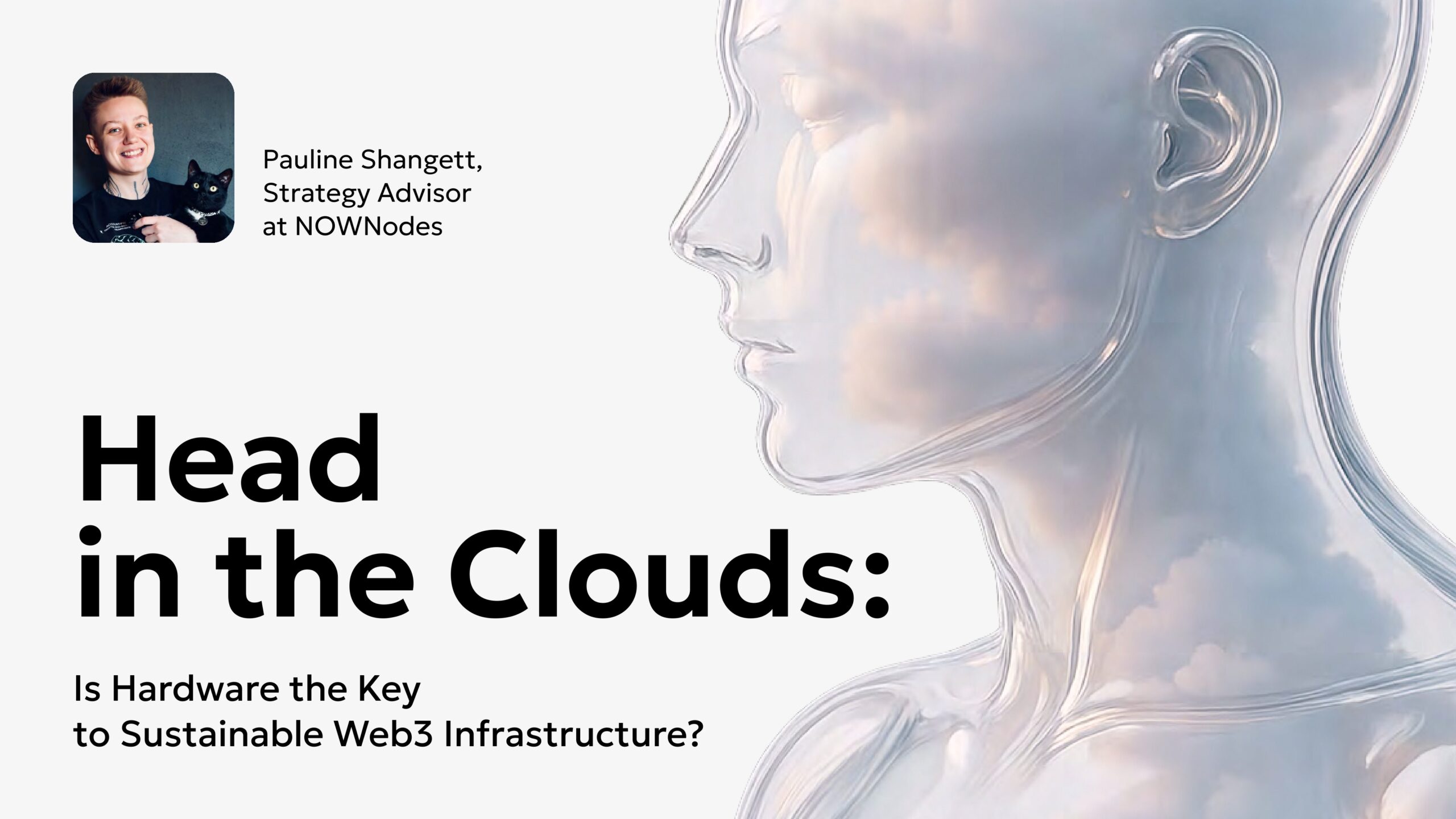WebX Asia this year felt like standing right at the crossroads of Web3’s future — buzzing energy, thought-provoking panels, and a community eager to push boundaries. Among the highlights was NOWNodes’ own Pauline Shangett, who took the stage with her talk “Head in the Clouds: Is Hardware the Key to Sustainable Web3 Infrastructure?”. Pauline’s session struck a chord, challenging the audience to rethink what true sustainability in Web3 really means — and whether the answers lie not only in code and cloud, but in the very hardware powering our decentralized future.
Head in the Clouds: Is Hardware the Key to Sustainable Web3 Infrastructure?
Pauline: What’s the scariest thing for a CTO? The hack? Maybe it’s the moment when everything fails without warning.
One fire. One missed update. One overloaded endpoint.And your Web3 product is offline.
Not hacked. Not rugged. Just…gone.
That’s when infrastructure becomes the only thing that matters. So… cloud or hardware?
And yeah, I’m not a CTO. But I’m Pauline Shangett, Strategic Advisor at NOWNodes.
I talk to teams, founders, support, infra guys, chain leads every day. So this isn’t a technical overview. This is a reality check.
What’s easy to love about the cloud?

Let’s start with what’s easy to love about the cloud: scalability, speed, and no hardware to babysit. But I won’t repeat what you already know. Let’s talk about something less obvious – security.
Because ironically, when people ditch the cloud, they often say it’s for “safety”. To protect against control, censorship and intrusion.
The bigger threats

But look around guys, the biggest threats to hardware aren’t cyber. They’re physical.
Look: In 2022, a fire in KakaoTalk data center in South Korea took down payments, logins, even access flow on Upbit. It wasn’t a hack. It was smoke.
A single physical failure escalated into a national crisis.And that’s not some rare “freak” event.
Physical risk is operational risk

Today, crypto winter isn’t just about price crashes.
It means real-world crises: wars, floods, power outages, cut cables, and burned data racks.
The world is unstable. Physical risk is operational risk. But the infra world has learned: you can’t control geopolitics, but you can control resilience.
And that’s exactly what we focus on at NOWNodes. We don’t ask if something will go wrong.
We ask when.
Cause building sustainable infrastructure means planning for failure before it happens.
Our systems are distributed across multiple strategic regions including the EU, US, and Asia, with physical presence in countries like Germany, Finland, the Netherlands, the United States and Singapore.
This isn’t about ticking boxes. It’s about placing nodes where they can survive: politically, geographically and technically. But beyond distribution, we invest heavily in redundancy.
We follow a 2N+1 architecture. That means for every critical component, power, compute, network – we dont just have one backup. So if one system fails, traffic instantly shifts.
If a second system fails – same thing. No downtime. Just smooth failover. We also simulate failovers regularly.
We shut systems down on purpose to see what breaks. Not in production, obviously, but in mirrored environments. We stress test, attack test, and region test.

About Cost

Now let’s talk about cost. Five years ago, cloud infra was a no-brainer. Cheaper, “pay-as-you-go,” and no massive upfront bill for hardware. That was the pitch.
But the equation’s changed. The Big 3 cloud giants have the market in a headlock. And when there’s no real competition, prices only move one way…up. That’s how monopolies work.
AWS compute costs jumped over 20% in just a year. Nearly 40% of companies saw their cloud bills spike by more than 25% in the past 12 months.
Some Calculation

Meanwhile, running your own hardware hasn’t gotten more expensive, it’s gotten more predictable.
Yes, you pay more on day one. But over 7–10 years, the math flips. Owning your own servers can cost one-third to one-half of what you’d spend on the equivalent in the cloud.
One engineer calculated that an $1100 server works out to about $110/month over a decade.
The same power in the cloud? $2,000 to $7,000 a month.
And there’s something else: hardware gives you more freedom. With metal, you can patch, tweak, and deploy things the way you need. The cloud limits you to what they offer; metal doesn’t.
Let’s Zoom Out

But let’s zoom out. Because this isn’t just a story about what you run your service on.
It’s about who runs it for you. Neither cloud nor hardware will save you if your provider ghosts you at 3AM, fails to scale, or can’t explain outages. And that’s where things get real.
At NOWNodes

At NOWNodes, we provide blockchain infrastructure. We serve teams from early-stage DApps to large exchanges and wallets.
When we ask: Why us?
The answer is almost never because of your hardware.
They say things like:
1. Because you answered in 3 minutes
2. Because you scaled with us without surprise billing
3. Because you support 115+ chains, not just the trendy ones
4. Because when our RPC crashed at 2AM, your team fixed it live
Our Solutions

Let me break it down. Backups: If something can fail…it will.
Nodes go down. Block height freezes. Chain updates break interfaces.
So what do you restore? Last week’s state? Last month’s? We run geo-distributed backups So your worst day becomes a bump, not a blackout.
Multichain Reach:
Most providers support 50-70 blockchains. Only 3 to 5 providers can proudly claim a milestone of supporting 100+ chains, and NOWNodes is one of them.
We support 115+ and are adding new ones as I’m speaking right now. Also we’re the only provider on the market offering shared-node infrastructure for some of the most complex and often-overlooked chains, including: Monero (XMR), eCash (XEC), Nano (XNO) and many others.
Because your users won’t wait for you to “maybe add support later.” They’ll leave.

Support:
We don’t believe in chatbots. We don’t believe in “ticket escalations.” We believe in real engineers in your Telegram or Slack solving real problems in real time. Average response time: under 3 minutes.
Resolution time: hours, not days, even for deep bugs.
That’s not a premium feature.That’s the bare minimum.
Pricing:
Here’s how most RPC providers work: Complex tiers you can’t predict. Hidden throttle limits.Price jumps the moment you cross an invisible line. Then something goes viral. Or a botnet spikes your traffic. And suddenly, your bill triples overnight.
Wait…or worse, they cap your service mid-transaction.
We do things differently. Yes, our pricing is subscription-based, with clear request limits. But you always know exactly what you’re paying for. And when you need more capacity, scaling is predictable, fast, and fairly priced, not a hostage negotiation.
Our clients stay because they can plan their growth without fearing their infra bill.
Is hardware the key to sustainable Web3 governance?

So… is hardware the key to sustainable Web3 governance?
No.
And neither is cloud. The real key is resilience. And resilience comes from:
- Smart and distributed backups
- Fast and human-centric support
- Transparent and scalable pricing
- Full multichain support
- Infrastructure you can grow with …not grow out of
That’s not something you rent. That’s something you build.

So infra is boring until it’s not. Until your endpoint falls, your TVL disappears, your users rage quit and your logs say nothing. Thats when you realize. Infrastructure is trust between your product and the people who keep it online.



